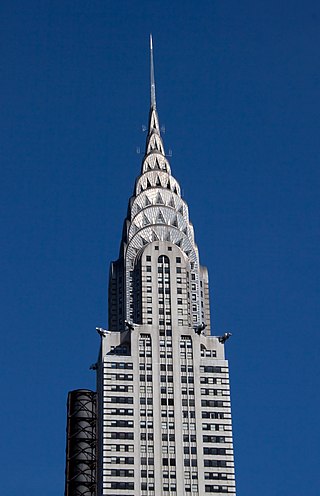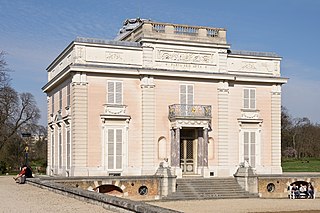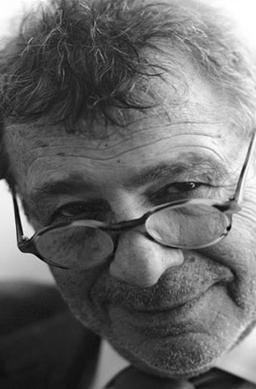Related Research Articles

Art Deco, short for the French Arts décoratifs, is a style of visual arts, architecture, and product design, that first appeared in Paris in the 1910s, and flourished in the United States and Europe during the 1920s to early 1930s. Through styling and design of the exterior and interior of anything from large structures to small objects, including how people look, Art Deco has influenced bridges, buildings, ships, ocean liners, trains, cars, trucks, buses, furniture, and everyday objects including radios and vacuum cleaners.
Delphine Caroline Marie Arnault is a French businesswoman. She is a director and executive vice president at Louis Vuitton, as well as the chairwoman and chief executive officer of Christian Dior Couture. She is the daughter of Bernard Arnault and sister of Antoine Arnault.

Jean Prouvé was a French metal worker, self-taught architect and designer. Le Corbusier designated Prouvé a constructeur, blending architecture and engineering. Prouvé's main achievement was transferring manufacturing technology from industry to architecture, without losing aesthetic qualities. His design skills were not limited to one discipline. During his career Jean Prouvé was involved in architectural design, industrial design, structural design and furniture design.

The Musée des Arts Décoratifs is a museum in Paris, France, dedicated to the exhibition and preservation of the decorative arts. Located in the city’s 1st arrondissement, the museum occupies the Pavillon de Marsan, the north-western wing of the Palais du Louvre. With approximately one million objects in its collection, the Musée des Arts Décoratifs is the largest museum of decorative arts in continental Europe. It is one of three museums operated by the non-profit arts association MAD, founded in 1882.

François-Joseph Bélanger was a French architect and decorator working in the Neoclassic style.

Piper-Heidsieck is a Champagne house founded by Florens-Louis Heidsieck in 1785 in Reims, France. Piper-Heidsieck was acquired on July 8, 2011, by the French luxury group EPI, controlled by the Descours family. Before that, the house was owned by the Rémy Cointreau wine and spirits group since 1988.
Pierre Balmain S.A., trading as Balmain, is a French luxury fashion house that was founded by Pierre Balmain (1914–1982) in 1945.
Louise Vava Lucia Henriette Le Bailly de La Falaise, known as Loulou de la Falaise, was an English fashion muse and accessory and jewellery designer associated with Yves Saint Laurent. Author Judith Thurman, writing in The New Yorker magazine, called La Falaise "the quintessential Rive Gauche haute bohémienne".
The Musée de la mode et du textile was a museum located in the Louvre Palace at, 107, rue de Rivoli, in the 1st arrondissement of Paris, France. It is now a department of the Musée des Arts Décoratifs, Paris. Works from the former museum are regularly displayed in temporary exhibitions.

Antoni Clavé was a Catalan master painter, printmaker, sculptor, stage designer and costume designer. He was nominated for two Academy Awards for his work on the 1952 film Hans Christian Andersen.

The Albert Londres Prize is the highest French journalism award, named in honor of journalist Albert Londres. Created in 1932, it was first awarded in 1933 and is considered the French equivalent of the Pulitzer Prize. Three laureates are awarded each year. The three categories are : "best reporter in the written press", "best audiovisual reporter" and "best reporting book".
Maison et Objet is a major French trade fair for interior design. Held bi-annually in Paris Nord Villepinte Exhibition Center, it has been described as "among the 3 most important European events for interior design ... a huge collection of innovation and talent all in one place."

Jorge Cañete is a Swiss interior designer, born in Geneva and of Catalan and Andalusian origin. He has received several awards including the 2014 Interior Designer of the Year Award in 2014.

Joseph Ettedgui, usually known simply as Joseph, was an influential London-based retailer and founder of the Joseph retail empire. After his death, the chair of the British Fashion Council Harold Tillman described him as: "a great designer, retailer and entrepreneur". Le Figaro fashion editor Godfrey Deeny has described him as: "one of the half dozen greatest fashion retailers in the past half-century".
Alexandre Vauthier is a French haute couture fashion designer.
Philippe Maidenberg is a French, Paris-based architect, interior designer and furnishing designer.

Sophie Mallebranche is a French artist and textile designer known for her woven metal materials that mix fibers and industrial materials.
Studio Berçot was a private training institute in fashion design, established in 1954, based in Paris and related to French fashion schools. It´s last season as Paris´ most creative cradle of talents was summer 2023.

Franklin Azzi (French: [fʁɑ̃klɛ̃ azzi]; born 12 August 1975 in Paris), is a French architect. He is a graduate from the École Spéciale d'Architecture, and the Glasgow School of Art. He is the founder of Franklin Azzi Architecture, an agency based in the 2nd arrondissement of Paris.

Marc Berthier was a French designer and architect. His works have made their way into the permanent collections of museums in France and across the world, such as the Centre Pompidou and the Museum of Modern Art. He was a Knight of the Ordre des Arts et des Lettres and received the Grand prix National de la Création Industrielle from the Ministry of Culture, succeeding Roger Tallon. He directed faculty at the École nationale supérieure de création industrielle from 1985 to 2000 in addition to his work alongside Dimitri Avgoustinos.
References
- ↑ Matthew Donaldson, "In Residence: Joseph Dirand", Nowness, 15 March 2015.
- 1 2 3 Tom Delavan, "The Reinvention of Minimalism", T Magazine, The New York Times , 10 April 2014.
- 1 2 3 4 5 6 Suleman Anaya, "The Creative Class | Joseph Dirand, Architect", The Business of Fashion, 21 November 2013.
- 1 2 3 4 5 Oscar Beltrán Gómez, "Joseph Dirand, redefiniendo el retail" Archived 26 January 2016 at the Wayback Machine , Axxis, 4 May 2015 (in Spanish)
- 1 2 3 4 5 6 7 Ian Phillips, "Designer Spotlight: Le Minimalist", Introspective, March 2014.
- ↑ Sophie De Santis, "Joseph Dirand, un esthète moderne dans le VIIe", Le Figaro , 22 October 2014 (in French)
- 1 2 3 4 5 Sophie Rosemont, "Le week-end de Joseph Dirand" Archived 26 January 2016 at the Wayback Machine , Vanity Fair (French edition), 17 February 2015 (interview) (in French)
- ↑ "La première édition de l'exposition AD Collections au Quai d'Orsay" Archived 26 January 2016 at the Wayback Machine , Vanity Fair (French edition), 26 March 2015 (in French)
- ↑ Delphine Roche, "Joseph Dirand, architecte et designer, présente sa première collection de mobilier en nom propre" Archived 22 March 2016 at the Wayback Machine , Numéro, 24 July 2015 (in French)
- ↑ Delphine Roche, "Joseph Dirand fusionne avec brio architecture et design pour sa très réussie première collection", Numéro, 8 December 2015 (in French)
- ↑ Jen Renzi, "Joseph Dirand, un modernista moderno" [ permanent dead link ], Wall Street Journal (Spanish edition), 18 December 2015 (in Spanish)
- 1 2 3 Cédric Saint André Perrin, "Vue sur le ciel de Paris", AD (French edition), 11 July 2013 (in French)
- 1 2 3 4 5 Sophie De Santis, "Maison & Objet a 20 ans: les 4 designers à retenir", Le Figaro, 12 January 2015 (in French)
- 1 2 3 4 Félicia Rouret, "Courchevel au sommet... L´Apogée", Le Figaro Madame, 23 February 2014 (in French)
- ↑ Maurice Beaudoin, "Loulou, un nouveau restaurant dans les jardins du Louvre", Le Figaro, 13 June 2016 (in French)
- 1 2 "Talents pluriels", Le Figaro Madame, 25 January 2013 (in French)
- ↑ "Joseph Dirand: scènes d'intérieur 2013 year designer" Archived 4 March 2016 at the Wayback Machine , Maison & Objet Paris, [2013], retrieved 16 September 2016